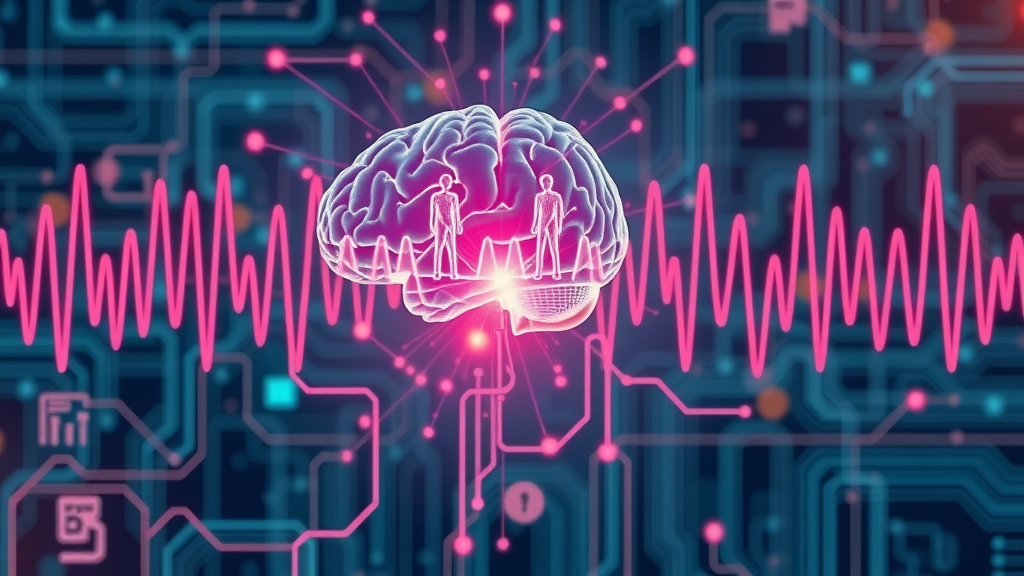
Startling Statistic: Almost 6.1 million children in the United States are diagnosed with ADHD, and traditional treatments still leave many searching for focus.
What if science offered a way to reshape the brain’s attention patterns without medication side effects? Enter neurofeedback for ADHD: a breakthrough therapy that’s gaining ground, challenging skepticism, and restoring hope—for both kids and adults—by tapping directly into our brain’s electrical rhythms. Whether you’ve struggled with attention deficit for years or are exploring neurofeedback protocols for children with ADHD , this guide offers answers, practical steps, and firsthand discoveries you won’t want to miss.
Neurofeedback for ADHD: Surprising Science That’s Changing Minds
Neurofeedback for ADHD is stepping out of the shadows and into mainstream attention as parents, educators, and practitioners search for effective alternatives to medication. Neurofeedback—a form of EEG biofeedback —uses real-time readings of brain waves to help individuals retrain their attention patterns. By providing immediate visual or auditory feedback based on the person’s own brain activity , neurofeedback protocols work to strengthen the brain’s ability to sustain focus, manage impulses, and calm hyperactivity.
Unlike stimulant medications, which may come with side effects such as appetite changes or sleep problems, neurofeedback is non-invasive. Growing evidence suggests its efficacy in reducing ADHD symptoms —especially when standard protocols are closely followed. A key reason for its rise is that it gives hope to families who have found medication-only approaches lacking or intolerable. By targeting the unique brain wave patterns associated with attention deficit, neurofeedback for ADHD is rewriting what’s possible for treatment.

From Skepticism to Support: Why Neurofeedback Protocols Matter in Treating ADHD
Initially, neurofeedback faced skepticism—was it just another wellness trend, or did it truly offer help? That skepticism is fading as research shows that strict adherence to neurofeedback protocols can lead to lasting improvements in people with attention deficit and hyperactivity disorder . These standardized approaches account for different age groups, ADHD symptom presentations, and even adjust feedback for beta waves or theta waves —particular brain wave frequencies linked to focus and distraction.
Clinicians now emphasize evidence-based protocols over generic or “one-size-fits-all” neurofeedback training. Following a standard protocol means using validated placements and feedback systems for the unique challenges of ADHD. Without the rigor of these protocols, results may be mixed—fueling earlier doubts. But with recent advances and precise calibration of EEG biofeedback , neurofeedback for ADHD is becoming a trusted pillar in the broader toolkit for treating attention deficit and hyperactivity disorders.
What You’ll Gain by Understanding Neurofeedback for ADHD
- Discover how neurofeedback for ADHD compares to conventional treatments
- Evaluate the efficacy of neurofeedback based on current research
- Learn about various neurofeedback protocols and standard protocols
- Understand potential risks, costs, and benefits for children with ADHD and adults
- Get answers to pressing FAQs about neurofeedback treatment

Neurofeedback for ADHD: A Personal Perspective
Living with Attention Deficit: The Everyday Challenges
Living with attention deficit means more than momentary distractions. For both children and adults, it’s an ongoing battle—a relentless struggle to concentrate during class, at work, or even in conversations. For many individuals with ADHD, even the simplest tasks—like sitting still, finishing homework, or remembering instructions—become Herculean challenges.
The constant cycle of distraction extends beyond mental focus, affecting self-esteem, relationships, and overall mental health . Whether as a frustrated parent watching a child struggle, or as an adult swept up in the chaos of missed deadlines, the impacts of attention deficit and hyperactivity disorder ripple across home and school life. This is why so many search for new solutions once stimulant medication alone no longer feels enough.
First Encounters: My Introduction to Neurofeedback Training
My discovery of neurofeedback training began when traditional ADHD treatment options plateaued. A sense of hope came from stories of families who found neurofeedback therapy life changing. Initially, skepticism set in, mirroring what many parents and adults feel—can “video games” for your brain truly calm constant mental static?
That changed after witnessing firsthand how neurofeedback protocols could help retrain my child’s brain activity: by reinforcing the brain waves associated with calm focus and reducing those linked to impulsivity, sessions made an unmistakable difference. Appointments became a cherished routine—clearer homework sessions, fewer emotional outbursts, and a growing confidence that real progress was happening, not just a placebo effect. Neurofeedback for ADHD is, for many, a bridge to the real focus they never thought possible.
Understanding Neurofeedback Protocols for Attention Deficit and Hyperactivity Disorder
Defining Neurofeedback for ADHD and EEG Biofeedback
Neurofeedback for ADHD —also called EEG biofeedback —is grounded in the science of operant conditioning. During a session, sensors placed on the scalp measure brain waves such as beta waves (linked with focused attention) and theta waves (associated with daydreaming and distractibility).
The neurofeedback software displays this brain activity in real-time, providing visual or auditory signals when attention-related waves rise or fall. Over repeated sessions, the brain learns to produce healthier patterns, much like learning to ride a bike or play an instrument. This type of eeg biofeedback targets the neurological roots of ADHD symptoms , helping to rebalance the distinctive markers of attention deficit and hyperactivity disorder—without medication.
Unlike passive forms of therapy, neurofeedback is highly interactive and is tailored to the individual’s needs. Whether aiming to suppress excess theta waves in a fidgety child or boost beta power for an adult with attention issues, the approach can be adapted for each unique presentation of deficit hyperactivity.
Reviewing Standard Protocols in Neurofeedback Treatment
Not all neurofeedback protocols are equal. Standard protocols—those validated by clinical research—determine the sensor locations, feedback modalities, and session pacing necessary for the best efficacy of neurofeedback . For children with ADHD , protocols often focus on reducing the theta/beta ratio in frontal and central regions of the brain, directly targeting impulse control and focus.
For adults with ADHD, protocols might emphasize sustaining higher beta wave activity and minimizing distractions from lower-frequency waves. Adhering to a standard protocol ensures safety and maximizes results—experimenting with unproven methods risks inconsistent outcomes and disappointment.
Research continues to refine these approaches. The most effective protocols follow set guidelines regarding session length (often 30-45 minutes), frequency (2-3 times per week), and total duration (20-40 sessions for optimal, lasting gains). Your practitioner’s expertise—and their commitment to standard protocols —can make all the difference in your neurofeedback journey.
| Population | Main Protocol | Brain Wave Focus | Session Frequency | Expected Results |
|---|---|---|---|---|
| Children (6–12 yrs) | Theta/Beta training (frontal/central) | Decrease theta, increase beta | 2-3/week | Improved attention, reduced hyperactivity |
| Adolescents (13–17 yrs) | SMR (sensorimotor rhythm) training | Enhance SMR, stabilize beta | 2/week | Better self-regulation, focus |
| Adults (18+ yrs) | Beta training (frontal/parietal) | Increase beta, reduce distractibility | 1-2/week | Sustained attention, reduced symptoms |

How Neurofeedback Training Works for Children with ADHD
Real-World Examples: Neurofeedback Sessions for Children
Imagine a young child, headphones on, sitting comfortably as animated visuals respond to their brain activity . This is neurofeedback training in action. Each time the child’s brain produces more focus-associated beta waves and less distractible theta waves , the cartoon advances, earning points or rewards. Over time, the child learns—subconsciously at first, then with intention—to manage their attention, translate feedback into classroom focus, and even reduce impulsivity at home.
Parents report that their children, formerly overwhelmed in noisy environments or easily frustrated, begin to experience calm, accomplishment, and greater self-worth. Unlike traditional treatment of ADHD that may require increasing medication doses or coping with side effects , neurofeedback for ADHD empowers children as active participants in their own progress.

Efficacy of Neurofeedback: What Does the Research Say?
Key Studies on Neurofeedback for Attention Deficit Hyperactivity Disorder
Dozens of studies now support the efficacy of neurofeedback for ADHD. In randomized controlled trials, children and adults who received EEG biofeedback based on standard protocols showed marked improvements in attention, reduced impulsivity, and decreased overall ADHD symptoms compared to control groups. Notably, the best results emerge when practitioners strictly follow evidence-based neurofeedback protocols rather than bespoke, experimental setups.
Emerging research supports the theory that rebalancing the theta/beta ratio in frontal brain regions via neurofeedback seemingly mimics the effect of certain stimulant medication s—yet avoids their common side effects . Still, “ more research is needed ” for long-term comparisons, particularly regarding the potential for neurofeedback to replace or reduce ongoing medication for attention deficit hyperactivity disorder . Nonetheless, success stories and data continue to grow, making neurofeedback a compelling option for families seeking to reduce ADHD symptoms naturally.
“Neurofeedback has been transformative for many children with ADHD when standard protocols are closely followed.”
Who Benefits Most from Neurofeedback for ADHD?
- Children with ADHD struggling with medication side effects
- Adults seeking alternative treatments for attention deficit hyperactivity
- Families aiming to reduce hyperactivity disorder symptoms naturally
Potential Drawbacks and Considerations of Neurofeedback Protocols
While neurofeedback for ADHD offers exciting promise, it’s not without caveats. Not everyone responds equally; some may see rapid improvement, while others notice subtler changes after many sessions. Key variables include the expertise of the practitioner, strict adherence to standard neurofeedback protocols, and the child’s or adult’s ability to attend frequent sessions.
Another consideration is that outside factors—like inconsistent attendance or poorly calibrated feedback—can limit outcomes. While there are generally minimal side effects , rare issues such as mild headache or fatigue have been noted. It’s crucial to choose clinics that prioritize safety, transparency, and ethical standards. Most importantly, families must set realistic expectations: neurofeedback requires patience, effort, and an openness to incremental progress rather than instant transformation.

Making Sense of Neurofeedback Costs, Coverage, and Accessibility
| Type of Service | Average Cost Per Session | Total Sessions Needed | Insurance Coverage |
|---|---|---|---|
| Initial Assessment | $150–$300 | 1 | Rarely Covered |
| Individual Session (Child/Adult) | $75–$250 | 20–40 | Sometimes (varies by provider) |
| Total Program | $1,500–$10,000 | 20–40 | Rarely Fully Covered |
Practical Steps: Starting Neurofeedback Training for ADHD
- Consult with a licensed neurofeedback practitioner
- Ensure protocols align with recommended standard protocols
- Adjust expectations—outcomes vary and consistency is key

Frequently Asked Questions About Neurofeedback for ADHD
Is neurofeedback for ADHD effective?
Research studies have shown that neurofeedback for ADHD can help improve attention and reduce hyperactivity symptoms, particularly when standard protocols are followed consistently. However, results may vary for each individual, and more large-scale studies are encouraged to further validate these findings. Neurofeedback is especially promising for those seeking non-medication options or who have not responded well to stimulant medication .
What is the 24 hour rule for ADHD?
The 24 hour rule refers to the importance of consistency in routine and interventions for individuals with ADHD. In neurofeedback for ADHD, this means maintaining regular session schedules to maximize efficacy and maintain progress. Adhering to a strict session routine is recommended so the gains in attention and focus are reinforced, both neurobiologically and behaviorally.
Does insurance cover neurofeedback for ADHD?
Insurance coverage for neurofeedback for ADHD varies significantly. Some plans may cover neurofeedback treatment when prescribed for mental health or behavioral therapy, while others still consider it experimental and do not reimburse. It’s essential to consult the official website of your insurance provider and request pre-authorization or clarification on coverage before beginning a full neurofeedback program.
How much does neurofeedback cost for ADHD?
The cost of neurofeedback for ADHD typically ranges from $75 to $250 per session, depending on practitioner expertise and location. Most individuals require between 20 and 40 sessions for lasting improvement, adding up to a total program cost that can exceed several thousand dollars. Always check with your practitioner and insurance provider for precise estimates and potential out-of-pocket expenses.
What the Experts Say: Quotes on the Efficacy of Neurofeedback for Attention Deficit Hyperactivity
“While neurofeedback is not a cure-all, the efficacy of neurofeedback for attention deficit hyperactivity disorder is now supported by a growing body of evidence.”

Final Thoughts: Weighing the Future of Neurofeedback for ADHD and Mental Health
Is Neurofeedback the Disruptive Solution ADHD Needs?
Neurofeedback for ADHD is not a magic bullet, but its blend of brain wave science, real-world results, and non-invasive therapy is changing lives. As research grows and more providers adopt standard neurofeedback protocols, neurofeedback may become a leading, disruptively effective support for those with attention deficit and hyperactivity disorder. Parents, adults, and clinicians now have a science-backed alternative to explore—one that balances hope with grounded, ongoing progress.
Ready to Reclaim Focus? Explore Neurofeedback for ADHD and Take the Next Step

People Also Ask
Is neurofeedback for ADHD effective?
Research studies have shown that neurofeedback for ADHD can help improve attention and reduce hyperactivity symptoms, particularly when standard protocols are followed consistently. However, results may vary, and more large-scale studies are encouraged.
What is the 24 hour rule for ADHD?
The 24 hour rule refers to the importance of consistency in routine and interventions for individuals with ADHD. In neurofeedback for ADHD, this means maintaining regular session schedules to maximize efficacy and maintain progress.
Does insurance cover neurofeedback for ADHD?
Insurance coverage for neurofeedback for ADHD varies. Some plans may cover neurofeedback treatment under mental health or behavioral therapy, but many do not. It’s best to check with your provider for specifics.
How much does neurofeedback cost for ADHD?
The cost of neurofeedback for ADHD can range from $75 to $250 per session, depending on location and practitioner expertise. Most individuals require 20–40 sessions for lasting results.
Ready for a new chapter? Connect with a licensed neurofeedback practitioner—focus is possible, and the next step starts with science and you.
Neurofeedback for ADHD is an emerging therapy that utilizes real-time brainwave monitoring to help individuals retrain their attention patterns. By providing immediate feedback on brain activity, this non-invasive technique aims to enhance focus, manage impulses, and reduce hyperactivity without the side effects commonly associated with medication.
For a comprehensive understanding of neurofeedback’s role in ADHD treatment, consider exploring the following resources:
-
“Neurofeedback for Attention-Deficit/Hyperactivity Disorder: A Systematic Review and Meta-Analysis” ( pubmed.ncbi.nlm.nih.gov )
-
“Neurofeedback and Attention-Deficit/Hyperactivity-Disorder (ADHD) in Children: Rating the Evidence and Proposed Guidelines” ( pubmed.ncbi.nlm.nih.gov )
These articles provide in-depth analyses of neurofeedback’s efficacy, offering valuable insights for those considering this treatment option.
 Add Row
Add Row  Add
Add 



Write A Comment